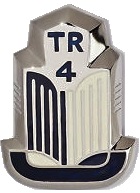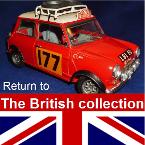
1961 Triumph TR4 Revell
Code named "Zest" during development the Michelotti styled TR4 was based on the TR3 but with a more modern look. Triumph's success with the TR2 and TR3 (TR being Triumph Roadsters) was quite impressive with over 65,000 TR2/3′s having been sold up to 1960. This gave the Standard Triumph Motor Company the confidence to look at upgrading their range.
These earlier TR's, and even Jaguars and MGs designs, were becoming old fashioned by the late 1950s and Standard-Triumph realised that the changing US market and ever increasing legislation on safety would require a more refined design. Buyers now wanted proper side windows, preferably with rollup-rolldown capabilities, better heaters and ventilation as well as more space for luggage. This consumer desire for more thrills and with more frills also led to the later 6 cylinder engines used in the later TR250, TR5, and TR6.
However, the firm also wanted to keep the proven features of the TR3 and keep costs to a minimum, so the new body would need to fit to the TR3 chassis and much of the running gear.
Michelotti's new TR4 was lower, wider and more up market than it's predecessors. The wider track was hidden under the flared wings and a the front hinged bonnet was flattened out although a raised hump was needed to clear the carburettor. The lines of the side panels was now parallel to the ground from the windscreen to the rear as the doors now housed the roll-up side windows (which also helped reduce the ingress of water when the top was up. Raising the rear wing height and making a more angular boot lid helped to give more luggage space as well as a home for the spare tyre. This design was noticeably different to the earlier cars and some features of it continued on through the following models to include the TR6.
The dash now had adjustable fascia ventilation and wood fascias could be had. Along with the chrome trim along the body and the TRIUMPH now being on the bonnet and the hood there was a more upmarket look to the car while it still being in line with the British sports car image. The full width grill housed the headlights, sidelights and indicators at the same time as giving more room in the engine bay for the motor itself.
Available as both roadster and coupe the the roadster was by far the more popular design. Technically speaking a roadster doesn't have roll-up windows but Triumph stayed with the name even though it would more accurately termed a convertible. The vinyl soft top had three plexiglass windows and was completely detached from the car when not in use. The “hood sticks” which held it up folded down into the rear of the cockpit covered with a panel behind the seats while the soft top was stored in the boot. Triumph missed a sales opportunity when they didn't market the hard top as a coupe. The hard top could be unbolted and taken off for top down motoring and another system, the Surrey top, was also available. This roof had the rear half of the normal hard top but with a built in roll hoop and a removable centre section rather like the now well known Porsche Targa top. At the time the Targa top was very unusual and not very well received, today these are the most desirable versions of the TR4 to own.
The engine was the same 1991cc pushrod unit as the TR2/3 producing 105bhp. Over time there were gradual upgrades, like boring out the engine to create a 2138cc unit and improving the manifolds and head until the larger engine could turn out over 200bhp. The gearbox had synchromesh on all forward gears and with the optional Laycock de Normanville electrically operated overdrive being available on 2nd, 3rd and 4th gears the TR4 effectively had a close ratio 7-speed 'box. Other improvements included the rack and pinion steering and improved suspension geometry, however IRS had to wait till the TR4a in 1964.
The debut TR4 rolled off the assembly line at Cranwell works in Coventry on the 18th of July 1961 and it was generally considered a good car by critics and proved then right as when production finished in 1965 40,253 TR4s had been built.
The TR4A of 1964 had a new chassis and improved independent rear suspension, although as much as 25% of TR4A production is thought to have been had the earlier live axel rather than the IRS system. Apart from the necessary adaptations to fit the new chassis the two versions are identical.









Revell (GB) released the TRIUMPH TR4 kit within a few years of the real TR4 hitting the streets. The same kit from the H-1254 series was re-released later in the 1960s and in the USA as well as in Britain.
Rod built this model in the early 1960s and gave it opening doors and boot. It also has door handles that serve as door catches! The engine and opening bonnet were part of the original kit. This is one of the first twenty models Rod built not longer after getting married, and long before Ian was born.
Airfix released their version of the Triumph TR4a, kit #M202C, also in1/32nd scale in 1966. It was re-released in 1967. A racing version of the kit was marketed by MPC, kit # 1007-100, in the 1970s and Airfix did a limited release in the 1990s. The latest offering of the kit is a starter set from the new Hornby owned Airfix company. Hornby injected new life into these kits in around 2009 by restoring the moulds and removing the large amounts of flash that had plagued the 1990s kits. These are now much more buildable again but can't really compete with modern kits from Japan. The Museum has an original Airfix kit and one of the latest starter kits, these are yet to be built.
RETURN TO :-
